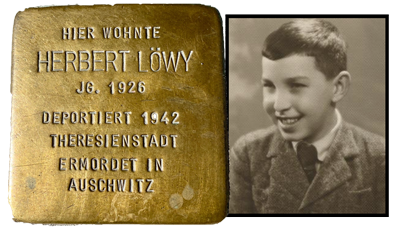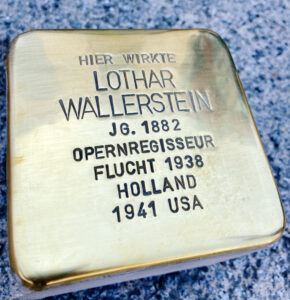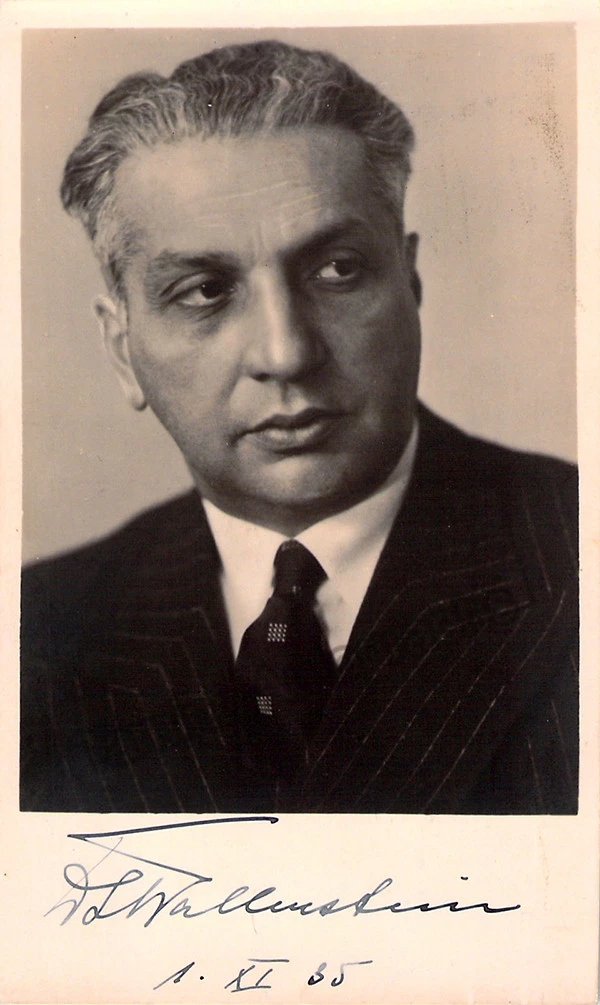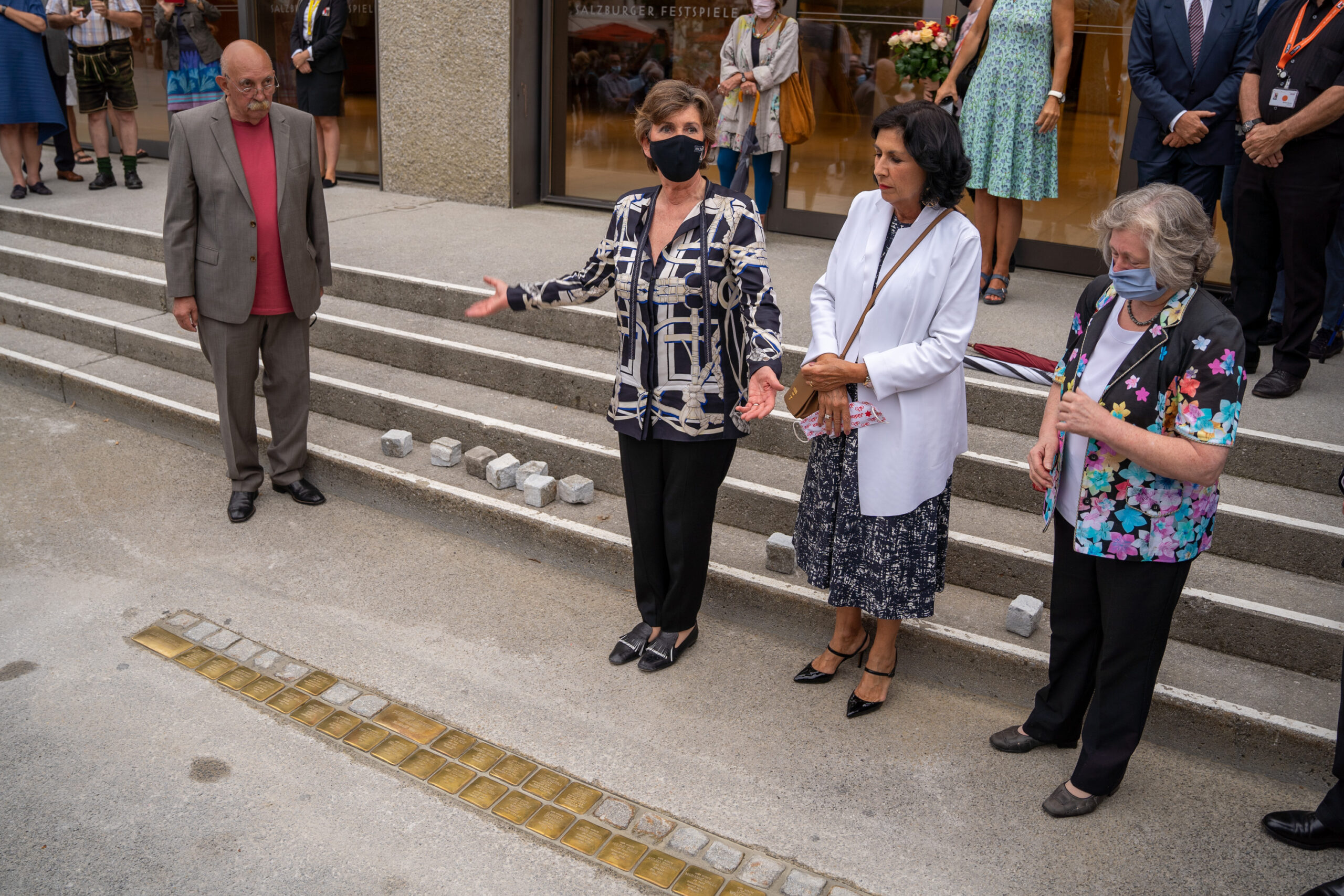Lothar WALLERSTEIN was born in Prague (Praha), Austria-Hungary (now the Czech Republic) on November 6, 1882. He was the fifth of the six children of the Jewish couple Bertha Wallerstein neé Reiniger and her husband Moritz Wallerstein – who was the senior cantor and choir director at the Maisel Synagogue, as well as the director of a private music school.
Moritz Wallerstein died on November 7, 1906; his funeral ceremony in the Maisel synagogue and his burial in the Jewish cemetery in Straschnitz (Strašnice) were described in detail in the Prager Tagblatt. His widow Bertha Wallerstein was also buried there after her death in 1930, but none of their children were.
Today we know that their children Gertrud, Viktor, Konrad and Therese and also their grandchildren Katharina, Heinz, Greta, Margot and Herbert did not survive the Shoah.
Gertrud, the eldest of the Wallerstein siblings, was the wife of the freight handler Max Tauber in Prague. Her brother Viktor Wallerstein Ph.D. was an art historian and owned an art gallery in Berlin.
Four siblings took up musical professions: Laura, who was trained by her father in his music school, was an opera singer in Graz who performed as »Lotte Westen« and married the lawyer Dr. Julius Bunzel. Her brother Konrad started as pianist, coach, and choir master in his father’s music school and ended as the professor for operatic singing at the German Music Academy in Prague.
Therese, the youngest of the six Wallerstein siblings, was a pianist who gave highly regarded concerts on two pianos in Prague with her brother Lothar:
The siblings Therese and Lothar Wallerstein, two born musicians, united in performing tone poems by Bach, Mozart and Liszt to create the finest and most harmonious pianistic collaboration.
Prager Abendblatt, November 7, 1914, p. 3
Lothar WALLERSTEIN was also a piano student of his father, but at his father’s request he studied medicine and in 1906 he received his doctor of medicine title in Prague. But rather than practice medicine, after his father died he attended the master class of the prominent Liszt student, pianist, conductor and composer Bernhard Stavenhagen at the Conservatory in Geneva.
Lothar WALLERSTEIN began his operatic career as a coach in Dresden in 1910 and advanced to the position of choir master and chief director at the City Theater of Posen (Polish Poznan).
On April 11, 1916, during the First World War, he gave a lecture on modern opera directing at Prague’s »German Women Artists Club«. He advocated a modern style for staging operas.
During the First World War he suspended his musical career and served as a military doctor, which won him an Officer’s Decoration of Honor from the Red Cross in 1918.
In the first years of peace Lothar WALLERSTEN worked as an opera director in Duisburg and Frankfurt am Main, where he made a name for himself with his enthusiasm for experimentation, according to a Vienna newspaper:
… during the new production of the ‘Valkyrie’ in Frankfurt under Dr. Lothar Wallerstein, to the horror of all orthodox Wagnerians beards were eliminated. Wotan, Siegmund, even Hunding all appeared without this popular decoration, which greatly enhanced the effectiveness of their facial expressions. In other ways, too, the scene design deviated from tradition in many ways….. The renewed ‘Valkyrie’ was an unusually strong success.
Der Tag, December 12, 1925, p. 7
At this time, the Vienna State Opera apparently lacked directors of sufficient artistic stature, so director Franz Schalk traveled to Frankfurt am Main to recruit Lothar WALLERSTEIN. The sought-after opera director agreed to make guest productions at the Vienna State Opera and at the Salzburg Festival.
In 1926, for the first time the program of the Salzburg Festival included an opera that was considered modern at the time: Ariadne auf Naxos by Richard Strauss and Hugo von Hofmannsthal (Libretto). It turns out that Richard Strauss pulled the strings behind the scenes: his favorite for the musical direction of his opera was Clemens Krauss, opera superintendent in Frankfurt am Main. Its director was Lothar WALLERSTEIN.
They were both designated as guests of the Vienna State Opera when they ingeniously staged the opera Ariadne auf Naxos with Lotte LEHMANN in the title role at the Salzburg City Theater (now the Landestheater) with the help of the architect and set designer Oskar Strnad – this »Salzburg Ariadne« was highly praised, even by the severe Vienna critic Paul Stefan (Grünfeld):
… For the first time a modern work, the opera ‘Ariadne auf Naxos’ by Richard Strauss, was included in the program of the festival, precisely the opera that is so lively connected with the baroque of the music and the baroque of the stage design. To put it simply: it was, alongside the ‘Fledermaus’, the height, the triumph of the Salzburg performances, perhaps their sensation despite ‘Turandot’.
Sensation especially thanks to the staging by Strnad and Wallerstein’s direction. Strnad was forced by the small size and shallow depth of the Salzburg theater to have the prelude played on stairs, corridors and in the actors’ changing rooms in a narrow space, but literally on two floors. For the actual opera he has a magnificent baroque arabesque as a stage frame, a modern Greco as a prospectus.
… In two rehearsals Wallerstein created an abundance of life, movement, and nuances, while eliminating everything rigid and dead, he created a work of art from a completely new spirit …
The jubilant thanks to all those involved, the conductor, the director and the stage painter showed what Salzburg could do if it didn’t just rely on the Austrian luck of improvisation, but wanted to work according to plans and systems.
P. Stf. Die Stunde, August 20, 1926, p. 8
The Viennese critic Paul Stefan, on the other hand, disliked the – all too improvised – Turandot staged by Max REINHARDT with the set design by Oskar Strnad in the festival hall.
It should be noted that REINHARDT wanted to produce Goethe’s Faust in the Felsenreitschule with Oskar Strnad’s production design in June 1926 – but it was canceled for some reason and replaced by Carlo Gozzi’s Turandot: perhaps on account of costs or intrigues.
Also unclear is why the »Salzburg Ariadne« with the original stage design by Oskar Strnad was not performed again in the next festival summers, neither in the city theater nor in the festival hall.
On August 13, 1927 the first opera was staged in the festival hall, which Clemens Holzmeister, architect and professor at the Vienna Academy of Fine Arts, transformed into an opera stage and furnished with sets,: Beethoven’s only opera Fidelio with Lotte LEHMANN as »Leonore« – directed by Lothar WALLERSTEIN as designated chief director of the Vienna State Opera.
This first opera production in the new festival hall was a success, at least according to the local music critic Otto Kunz:
… it was an existential question: can operas be performed in the festival hall? As is well known – God struck Salzburg with blindness at the time – It was built for ‘mystery plays’. The mysterious notion of building a stage without side stages, without backstage, without trap doors, without stage machinery, inevitably produced an almost insoluble jumble. The difficulties which that created – much to the detriment of the reputation of the Festival – are well known. The results of the final exam of the hall are now available: the answer to the question asked at the beginning is definitely “yes.” …
Prof. Clemens Holzmeister built the stage sets for ‘Fidelio’ in large cubic forms. As is well known, an artistically excellent solution often emerges from compulsion and necessity. And so it is here too. Holzmeister’s sets have style, size, and character.
They are an excellent expression of the time and classical earnestness of Beethoven’s music. Lothar Wallerstein’s direction is also praiseworthy. He subtly translates the dramatic increases and tensions of the music into motion …
Otto Kunz. Salzburger Volksblatt, August 16, 1927, p. 5
Lothar WALLERSTEIN’s production of Fidelio was performed 29 times in eleven festival summers from 1927 to 1937: under the musical direction of Franz Schalk, Clemens Krauss, Richard Strauss and most recently under Maestro Arturo TOSCANINI.
When WALLERSTEIN gave a lecture at the Mozarteum on August 25, 1926 on »problems with Mozart productions« the theater critics were silent as if there had been no problems.
In any case, it is documented in the annals of the 1928 to 1937 Festivals that Lothar WALLERSTEIN staged four Mozart operas: The Magic Flute, Don Giovanni and The Marriage of Figaro in the Festival Hall and Cosí fan tutte in the Stadttheater.
When, the Mozart opera The Magic Flute, apostrophized as the »Freemasonry Song of Solomon«, was staged for the first time in the festival hall in the summer of 1928, it became clear what the main problems were: the spatial difficulties that had to be mastered for the production.
But who would be credited as the creator of the Salzburg Magic Flute: the director Lothar WALLERSTEIN or the set designer Oskar Strnad?
After the premiere on August 18, 1928 in the Festival Hall the Vienna critic Rudolf Holzer was unequivocal in his judgment:
… Oskar Strnad is the creator of the new Salzburg production, which one has the feeling that it does not correspond to that of Schikaneder [the librettist and stage director of the premiere in 1791], but it does correspond to the popular and contemporary sense of fairy tale of the ‘Magic Flute’. Pictorial and scenic, truly perfect, this deepest and fairest fairy tale of southern German folk poetry came alive in Salzburg …
These prescribed staging principles were followed by Dr. Lothar Wallerstein in his direction.
Neue Wiener Journal, August 22, 1928, p. 11
The Salzburg critic Otto Kunz shared his opinion and concluded reporting a great success:
… The house was sold out. It was a great evening. Actors, conductors, set designers and directors are called out with storming applause.
Kunz. Salzburger Volksblatt, 20. 8. 1928, S. 6
On August 30, 1928, the festival audience was able to enjoy a last performance of the popular Magic Flute under the musical direction of Franz Schalk. It is hard to understand why there were no repeates of the successful production in the next festival summers.
For the further course of events it is of interest that in early summer 1928 a Mozart festival took place at Paris’ Opéra Comique under the musical direction of Bruno WALTER. He conducted five operas in a »Cycle de Mozart«.
The set designed by Oskar Strnad for the Paris Magic Flute was also impressive.
Bruno WALTER also conducted The Magic Flute in the festival summers from 1931 to 1933. The director in Salzburg was not Lothar WALLERSTEIN from the Vienna State Opera, but Karlheinz Martin from the Berlin Volksbühne, and on one occasion in August 1933 the stage designer Oskar Strnad – his grand debut as a director at the Salzburg Festival.
In a strange coincidence, in May 1933, a few weeks before Oskar Strnad’s directorial debut with Bruno WALTER in Salzburg, Lothar WALLERSTEIN re-staged Mozart’s Magic Flute with conductor Clemens Krauss at the Vienna State Opera using a stage set by Alfred Roller. They were almost simultaneous productions of the same opera, but with different leading teams on very different stages
Only the Vienna music critic David Josef Bach took the trouble to compare the parallel productions of the Magic Flute in Vienna and Salzburg:
… with all due respect for the Vienna work, the Salzburg performance is mentally, scenically and musically the superior one. This time, Oskar Strnad didn’t only understand how to make the spirit of the work visible as the stage designer, but also as the director …
Dr. D. J. Bach. Arbeiter-Zeitung, August 21, 1933, p. 3
It is also noteworthy that WALLERSTEIN staged operas at the Vienna State Opera in collaboration with Oskar Strnad, including new and daring operas that were forbidden under the Nazi regime: Jonny spielt auf (1927), Wozzeck and Schwanda, Der Dudelsackpfeifer (1930), and finally in May 1935 the opera already staged in Salzburg with Oskar Strnad Ariadne auf Naxos.
In September 1935, Oskar Strnad died in Altaussee at the age of 55 and was buried in an honorary grave of the Vienna Jewish Community (Oskar Strnad’s sisters Hermine and Hilda were Shoah victims).
In the summer of 1933 something unique and unexpected happened: chief director Lothar WALLERSTEIN staged the mystery play Jedermann by Hugo von Hofmannsthal in fascist Italy with Alessandro MOISSI in the title role.
Alexander MOISSI, who had last played the title role of Everyman in a Salzburg production of Jedermann in the summer of 1931, was not Jewish, but he was thought to be a Jew because his name sounded Jewish and he was often attacked as »the Jew Moissi«.
In Milan he played his famous role again: but this time in the Italian translation La Leggenda di Ognuno of Italo Zingarelli and a brilliant production by Lothar WALLERSTEIN. The premiere was on July 11, 1933 on the forecourt of the medieval Basilica di Sant’Ambrogio – with sensational success:
Moissi called it the `Most beautiful moment of my artistic life … When Alexander Moissi had finished his famous ‘Our Father’ at the end of yesterday’s performance, the audience broke into stormy applause after a moment of emotion.
Wiener Allgemeine Zeitung, July 12, 1933, p. 5
Moissi’s sensitivity here has to be deciphered: It hurt MOISSI deeply that he had to give up performing his favorite role in Salzburg in 1932 after a racist smear campaign against »the Jew Moissi« – especially because he didn’t get the full support of his impresario Max REINHARDT.
Thanks to Lothar WALLERSTEIN’s decision to employ him, MOISSI was again able to enjoy the public’s admiration before he died in March 1935 at the age of 55.
In the annals of the Salzburg Festival it is recorded that head director Lothar WALLERSTEIN staged twelve operas in twelve festival summers, five of them by Richard Strauss with Hugo von Hofmannsthal’s librettos:
• Ariadne auf Naxos, Die Frau ohne Schatten, Die ägyptische Helena and Elektra – with three performances each,
• Der Rosenkavalier – with 27 performances.
The Salzburg music critic Otto Kunz found an explanation for the continuing attraction of the Rosenkavalier, which Lothar WALLERSTEIN had staged for Salzburg in the summer of 1929 (Clemens Krauss conductor and Alfred Roller stage director):
… If there would ever be a question of making a musical work the Austrian National Opera, it would have to be Der Rosenkavalier. Maria-Theresian baroque, Viennese milieu, a flood of euphoria, splendor for the eyes and ears, wit and humor, laughter and tears, the gracefulness of music …
The cast is wonderful. Mrs. Lotte Lehmann, princely in appearance, regal in singing, human as woman …
The house presented an international, elegant, social image. The grandeur of the stage paired with the elegance of the audience, and you could calculate the external festivity of this evening from the sum of the horsepower of the approaching automobiles. There was a stormy ovation.
Kunz. Salzburger Volksblatt, August 5, 1930, p. 7
Even in the summer of 1933, despite the tourism boycott imposed on Austria by Nazi Germany, all of the Rosenkavalier‘s performances were sold out. Thanks to international and Jewish solidarity, the twenty-seventh performance on August 24, 1937 brought a record result: 485 limousines and ten horse-drawn carriages drove up to the Festival Hall.
In Salzburg it was Lotte LEHMANN’s last appearance as »the field marshal« – lots of glamor with strong political signals.
In the last two festival summers before 1938 there were three new productions by Lothar WALLERSTEIN in collaboration with Bruno WALTER: Der Corregidor by Hugo Wolf (1936), Euryanthe by Carl Maria von Weber and The Marriage of Figaro by Mozart and Da Ponte in Italian (1937). A fourth joint production was planned for 1938: Mozart’s and Da Ponte’s Cosí fan tutte in Italian.
The operas Fidelio, Rosenkavalier and The Marriage of Figaro, all as staged by Lothar WALLERSTEIN were on the 1938 festival program, which Joseph Goebbels dictated from Berlin as Minister of Propaganda. WALLERSTEIN’s name didn’t appear of course, as was also the case in Nazi ruled Vienna.
In March 1938 – even before the »Nuremberg Race Laws« came into force in Austria – Lothar WALLERSTEIN was expelled as chief director from the Vienna State Opera.
The Vienna State Opera had already scheduled a guest performance at the May Festival in Florence under the direction of Bruno WALTER where Lothar WALLERSTEIN was supposed to direct the opera Euryanthe.
But since a state visit to Florence by Adolf Hitler was announced, for the first time only »Aryan« musicians would be allowed to take part in Mussolini’s Florentine May Festival. As a result, the Viennese guest performance had to be canceled in March 1938
Lothar WALLERSTEIN had a holiday home on the Ligurian coast not far from Florence, to which he could retreat after his expulsion from Vienna. In addition, his brother Viktor Wallerstein, an expelled gallery owner from Berlin, lived with his family in Florence.
The circumstances of the death in Florence in 1944 during the war of his brother Viktor are still unclear. But Viktor’s wife Vera and their children managed to leave Italy after it was occupied by Germany and avoided being deported to the death camps.
According to unconfirmed sources, Lothar WALLERSTEIN worked as an opera director in Amsterdam from April 1939 and as a teacher at the Conservatory in The Hague – presumably until the bombing of Rotterdam and the German occupation of the Netherlands in May 1940.
He lived in hiding (in De Bilt near Utrecht) until he was able to flee in 1941. His actual escape routes – by land and sea – to Portugal are oscure. On the passenger list of the SS Excalibur, which left Lisbon on March 29, 1941 and arrived in New York on April 8, the name Lothar WALLERSTEIN is listed as »Hebrew«.
Two friends who collaborated to save him are also mentioned: Dr. F. Thienen in The Hague and Helen Taubler in New York City who lived at 126 Riverside Drive – which was also Lothar WALLERSTEIN’s address, when he signed his declaration to obtain US citizenship on August 19, 1941.
At this point it was already clear that he was the only one of the WALLERSTEIN siblings who could escape to the free world.
But when did he become certain about the deaths of his relatives in German death camps? Today databases at Yad Vashem and the Arolsen Archives are accessible online. You read data, facts, but don’t see people, faces or stories:
Lothar’s widowed older sister Gertrud Tauber and her daughter Katharina were murdered in Auschwitz.
Lothar’s brother Konrad, his wife Frieda and their daughter Margot were also murdered in Auschwitz; their son Heinz was killed in the Dachau concentration camp as a politically persecuted Jew.
Lothar’s younger sister Therese, once a celebrated pianist in Prague, was murdered in Maly Trostinec near Minskt along with her husband Emil Goldschmidt and their son Herbert.
Lothar’s sister Laura Bunzel, once an opera singer in Graz, and her daughter Greta, who had been born in Graz, were- deported to the Theresienstadt concentration camp on August 20, 1942 – one month after her husband Dr. Julius Bunzel had died in Vienna. From there, Greta was deported to Auschwitz where she was murdered.
Laura Bunzel survived the Theresienstadt concentration camp at the age of 68 and died in Vienna in 1962 – she was buried alongside her husband Julius in the Jewish section of the central cemetery
Four of the WALLENSTEIN siblings’ children survived the Shoah: Laura’s son Joseph Hans Bunzel, Konrad’s daughter Hanna Doris Ornstein, and Viktor’s children Franz Wallerstein and Gitta Perl.
How could they deal with their trauma, and live with it?
Both of Lothar WALLERSTEIN’s marriages, his first (1922) with the singer Margarete Pfahl and his second (1944) with the singer Mary Strug, remained childless. In November 1945 he was granted US citizenship.
WALLERSTEIN’s productions at the Metropolitan Opera with their German-language repertoire are now well documented and were outstanding: Lotte LEHMANN had her last appearance in Rosenkavalier in February 1945, the end of a splendid musical epoch.
From 1946 to 1949 WALLERSTEIN commuted as a guest director between his country of exile, the USA, and liberated Europe. He performed in The Hague, Amsterdam, London, Paris, Florence, Vienna and Salzburg.
In the 1946 Summer Festival WALLERSTEIN was supposed to renew a production of Don Giovanni in Italian from 1934 under Bruno WALTER with Oskar Strnad’s set design. The revival to revive the glamorous epoch was a success, but without the assistance of the guest director from New York, since he had missed the festival, »as a result of entry difficulties«.
In autumn 1946 Lothar WALLERSTEIN worked as a guest director in Vienna, at the Volksoper and at the Theater an der Wien, as the State Opera had been in ruins since March 1945. In November 1946 he was given the title of »Hofrat«. The Vienna press reported on this, but there was public silence about the death of his siblings in extermination camps – only mourning in private, behind closed doors with his sister Laura.
In the 1947 Summer Festival Lothar WALLERSTEIN was there on time as he only had to travel from Scheveningen at The Hague. He opened the Festival with a lecture on »The art of opera, opera an art«.
On July 28 Mozart’s Marriage of Figaro premiered in Italian. It was considered a new production by WALLERSTEIN, like the one in the summer of 1937 under Bruno WALTER’s direction.
It should also be noted that in the summer of 1947 Josef Krips and Otto Klemperer, two conductors who had been expelled from the Summer Festivals by the Nazis, conducted Mozart’s Figaro.
In the 1948 Summer Festival Figaro was conducted by Herbert von Karajan a favorite of Adolf Hitler who said he was »God-gifted« (in 1956 he became the artistic director of the Salzburg Festival).
In 1948 Lothar WALLERSTEIN was a guest director in Florence, Paris, The Hague, Scheveningen and elsewhere, just not in Salzburg.
In the 1929 Summer Festival Lothar WALLERSTEIN directed the musical comedy Der Rosenkavalier. Twenty years later, in the summer of 1949, he staged »Austria’s National Opera« again: this time under the musical direction of George Szell, also a displaced person, conductor at the Metropolitan Opera.
The premiere was on August 12, 1949. A review by Hermann Ullrich, a judge, music critic, composer and expellee, but one of the few returnees, appeared in the Neues Österreich daily paper:
Magnificent Rosenkavalier.
Lothar Wallerstein knew how to create something completely new out of a repertoire opera. He has not only swept away the dust and cobwebs that inevitably attach themselves to a long standing performance. He redesigned the work from the inside and entirely from the spirit of music, with an intuition for its values that not many directors have…
Dr. Hermann Ullrich. Neues Österreich, August 14, 1949, p. 5
It was Lothar WALLERSTEIN’s last guest production in Salzburg. He died in New Orleans on November 13, 1949 at the age of 67. In his obituary in Neues Österreich it said:
… With him one of the most distinctive apparitions from the heyday of the State Opera and a brilliant director has passed. His name will not be forgotten in the history of not only the institute [the State Opera] but also Viennese music.
Y. Neues Österreich, November 16, 1949, p. 4
His name might not be forgotten, but it is that until now his name did not exist in any of the public spaces in his former Austrian places of work, Vienna and Salzburg.
Quellen
- The Jewish Community/Israelitische Kultusgemeinde of Vienna
- The Vienna City and State archives
- The Salzburg Festival archives
- ANNO: Austrian Newspapers Online
- Österreichisches Musiklexikon Online
Translation: Stan Nadel
Stumbling Stone
Laid 17.08.2020 at Salzburg, Max-Reinhardt-Platz




